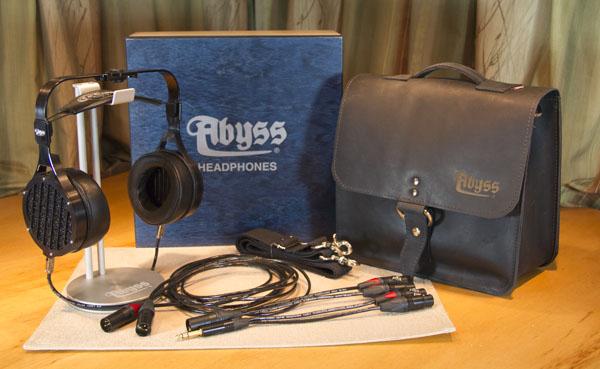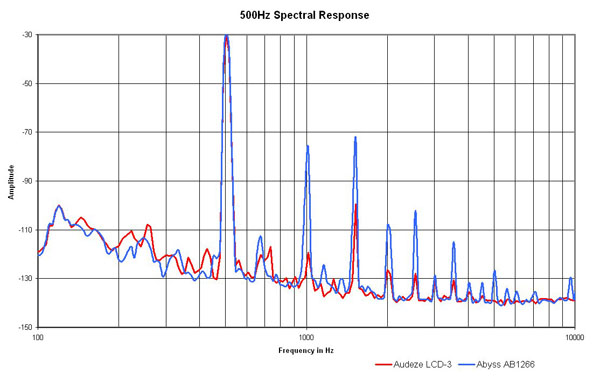| Columns Retired Columns & Blogs |
JPS Labs Abyss AB-1266 Planar Magnetic Headphones

This story originally appeared at InnerFidelity.com
JPS Labs Abyss AB-1266 Planar Magnetic Headphones ($5495)
The very unusual looking JPS Labs Abyss AB-1266 is an over-ear, open, planar-magnetic headphone. (Unusual looking? Let's not mince words, these headphones are butt-ugly.) But despite its odd looks and significant weight, they are surprisingly comfortable. Primary adjustment is accomplished at the top join of the two black anodized aluminum headband sides with a friction fitting that allows the space between the two earpieces headphones to be widened and narrowed, and which allows the ear-cups to be rotated a moderate amount forward and back. There is no tilt adjustment on the headband, but the large angled pads can be rotated to effectively change the tilt.
Looking at the headphones I was quite skeptical that this contraption would offer any degree of wearing comfort, but looks can be deceiving. Getting the headphones properly adjusted to my head took a little bit of fidgeting, but once I found the sweet spot they were surprisingly comfortable and relatively secure. I did find, however, that I could never quite get the headphones to seal with as much pressure at the bottom of the earpad as at the top. When I rotated the pads far enough to provide an even seal, the oval shape of the earpad opening was horizontal and my ear didn't fit properly in the cup. Fortunately, the aluminum headband is sturdy, and by firmly but carefully bending the vertical arms of the headband inward slightly the problem was solved. The AB-1266 uses a leather headband pad with internal padding suspended by what looks like rubber o-rings at either end; it nicely distributes the weight of the headphones over a good portion of the top of my noggin. At this point it's very easy to take the cans on and off my head, and long listening sessions are fairy comfortable.
This is probably a good time to mention that Joe Skubinski of JPS Labs recommends the headphones be adjusted to lightly seal against the head. During measurements of the headphones I spent quite a bit of time adjusting the headphones on the measurement head while watching a 30Hz square wave. It's quite easy to evaluate the performance of the seal in this way, and indeed I did find that the cans did perform best with a gentle but complete seal.
The build quality and materials apear to be top-notch. Black anodized aluminum and leather are used throughout. Two 8' long cables are terminated at each earpiece with mini-XLR connectors, and are specially made for the AB-1266 by JPS Labs using proprietary Alumiloy conductors. The amplifier end of the cables are terminated in full-size Neutrik 3-pin male XLRs. Accessories included with the Abyss headphones are plentiful and excellent. Included are: wood storage box; a very nice leather carry case with shoulder strap; an aluminum headphone stand; and two Y-adapters one with a 1/4" headphone plug and the other a 4-pin XLR. This may be the nicest set of accessories I've ever seen come with a headphone.
One-sided Planar Magnetic Drive
As unusual as these headphones are, the most unusual feature of these cans is their magnetic structure. Planar magnetic headphones typically have a magnetic structure that creates an iso-dynamic field in which the conductive elements are immersed. (You can read more about it here.) One of the drawbacks of this technique is the large magnetic structure needed on both sides of the diaphragm that create a significant acoustic impediment to radiated sound.
JPS Labs has taken a different approach with the AB-1266 using a magnetic structure that is on one side of the diaphragm only. I spent quite a bit of time exchanging emails and talking on the phone with Abyss designer Joe Skubinski to get an exact understanding of the AB-1266 driver design. Joe was very forthcoming with detailed information on the design, but considers it proprietary information, so I'll not describe the driver structure in detail. I can say that the magnet is a single large neodymium magnet with slots in it, and it's polarity is north on one face, south on the other. A very thin diaphragm with metal traces in a serpentine pattern are aligned very carefully behind the magnet—alignment is critical in this design.
JPS Labs does not claim the AB-1266 is an iso-dynamic design, and in my opinion it is not. As the diaphragm moves away from the magnet it will experience less magnetic field strength, when it moves closer to the magnet the field strength will increase. With iso-dynamic designs the field strength theoretically remains constant, at a minimum it will be symmetrical as the diaphragm moves forward and back. The asymmetrical magnetic field strength of the AB-1266 should mean that it has more second harmonic distortion than iso-dynamic designs.

Spectra of 500Hz tone at 100dBspl with the Abyss AB-1266 and Audeze LCD-3.(Vertical scale is not calibrated to dBspl.)
The above spectral plot shows a 500Hz tone being played at 100dBspl with the Audeze LCD-3 and Abyss AB-1266 and the resulting harmonic series. (I chose a fairly loud level to test so that distortion products were as significant as possible. As you can see, harmonic distortion overall is higher in the AB-1266, but second and fourth harmonic peaks at 1kHz and 2kHz are a significantly higher with the AB-1266. Even-order distortion plays a larger roll in the AB-1266 response than it does with the LCD-3.
It would be easy at this point to simply say more distortion is worse, but that's not necessarily true. If it were, tube amps would be universally worse sounding than solid-state amps, which is simply not the case for many listeners. I'll refer you to this article written by Nelson Pass where he discusses the issue. My motive for producing the plot above was to see if the AB-1266 had more even-order distortion possibly produced by the asymmetrical magnetic field...and it does. Though it's not certain the even-order distortion is being produced but the nature of the magnetic field, it's pretty good evidence.
The proof of the pudding however, is in the listening, which we'll get to on the next page.
- Log in or register to post comments




































